advertisement
20 April 2022
In late September of 2018, my friends and I ventured into the truly unreal experience that is Havasupai Falls and I’m here to share with you the good, the bad, the ugly, and everything in between.
I was fortunate enough to have a friend handle this aspect of the trip so unfortunately, I don’t have much first-hand experience obtaining a permit. If you need more guidance to obtain a permit, check out this post we did back in January. What I will say about my experience with the permit is that the patrol when you are hiking down and at the campsite is strict and on top of it. If you think you can sneak into Havasu Falls, think again.
advertisement
This was the first time I or my now husband had ever gone proper backpacking. For those who don’t know, backpacking means carrying your tent, your food, your everything on your back till you get to the campsite. Some friends already had the backpacking supplies they needed, others went the route of renting their supplies (which frankly, I wish I had gone this route; much cheaper). My husband and I with our optimistic hats on thought it would be a good idea to buy everything new because we’ll be backpacking more after this, surely (lol no, we haven’t used any of it since).
We took a trip to our local REI store and bought some essentials we didn’t own yet. This included:
We followed this REI guide which was pretty helpful for us newbies but we skipped heavy things like stove and fuel, kitchen supplies, and water-treatment supplies. We were only staying one night so we relied on sandwiches for food for the whole trip and there was fresh water at the campsite that was safe to drink. We still used iodine and taste-neutralizer tablets for the water at the campsite just to be extra careful, but some of our friends drank it straight and they were fine.
Here’s a list of what we already had that was essential:
When shopping for a backpack for backpacking, be sure to try them on and do your best to adjust the straps to maximize comfort. A helpful sales associate might be helpful when adjusting your straps, but my husband and I just winged it. Backpacking backpacks can range from $100 – $700 so if you’re purchasing one, think about it as an investment, but if you don’t feel like backpacking is going to become your next frequent hobby, the $200-$400 range is probably best. Keep in mind, that the more quality a backpack is, the more it’s designed to help ease the stress on your body.
The two hindsight items I wish I would have gotten were 1. a light backpacking friendly tent, and 2. new hiking boots. You’ll learn why later in the story.
advertisement
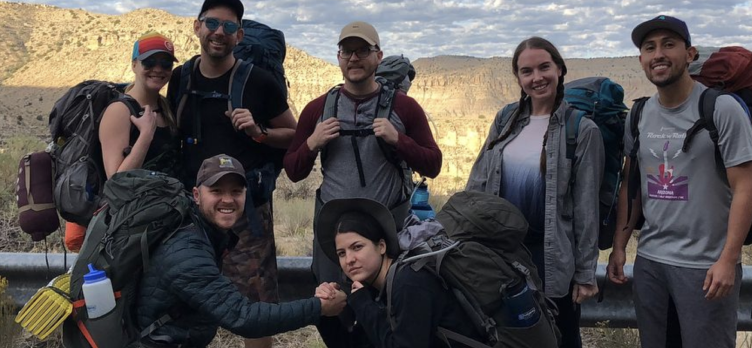
Something that we did, and I’m certainly glad we did, was staying at a hotel in Peach Springs the night before. It’s a 90-minute drive to the trailhead vs a 5-hour drive from Phoenix.
We woke up bright and early, drove to the trail start, and parked on the side of the street as close to the Hualapai Hilltop trailhead as we could find to kick off our adventure!
The earlier you start, the better — especially considering we were only staying one night. It gives you ample time to explore once you reach the campsite for the rest of the day.
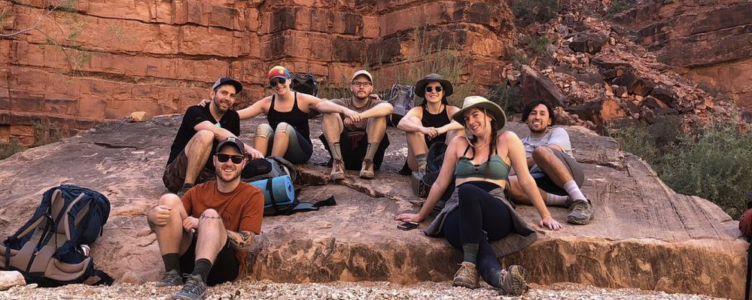
The first mile and a half of the hike feel like you’re going straight down. It’s a steep decline that gave me anxiety thinking about the reverse trip and climbing this beast. Once you’re down the decline, the hike feels doable but loooooong. I consider myself an athletic person — I bike about 10 miles a day give or take, but my fitness was not the correct fitness for this kind of stress on my body. And having a heavy backpack strapped to your back makes it challenging.
I was warned while studying up on the hike that the stretch of the hike after the decline can be brutal with the amount of sun exposure you could be subjected to. Fortunately for us, this didn’t seem to be the case. We made the trip on September 21st for some context. Perhaps that may be one of the best times to go because the weather felt perfect the whole trip.
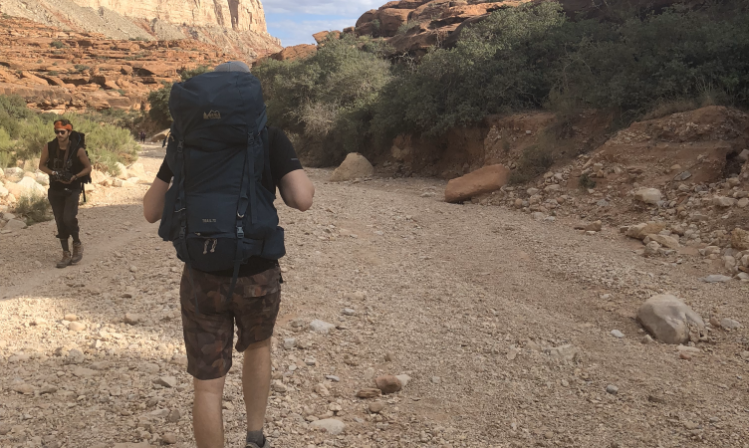
Be sure to take as many rests as you need to give your legs and your back a break, but don’t forget the more time you’re on the trail, the less time playing in the water. My friends were a pretty fit crew, but some had more backpacking experience than others our total hike time turned out to be a little over 5 hours, which is slightly above average.
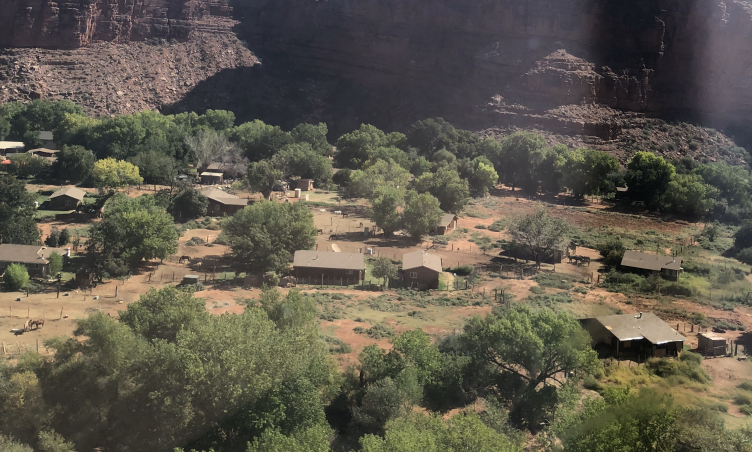
After 8 miles of hiking, you’ll arrive at the Supai Village. Don’t get too excited, you still have 2 miles to go before arriving at the campground (something I wish I had known beforehand). Here you need to check in at the front office. Again, I was fortunate enough that I had a friend who took care of all of that — I took that time as an opportunity to SIT.
Remember I mentioned I wish I had invested in good hiking boots? Well by now the strain of the trail and the weight of the backpack were starting to take a toll on my feet. The old hiking boots I had for years started to feel 2 sizes too small and I felt an ominous tingling in my feet. I decided to ignore it, because again, didn’t know it was another 2 miles to go, and I would pay the price.
As we started nearing the campsite, my feet started to go numb and my pace went down to a crawl. I finally relented and took my boots off to soak my feet in the beautiful blue water. I was startled to find my feet had turned purple! My friends gave them the name “zombie feet.”
Fortunately, after I gave them a rest, I hiked the rest of the way barefoot. Not ideal, but Will, my saint boyfriend (now husband) strapped my backpack to his back and helped me trek the rest of the way. My feet seemed to return to normal not being bound in the evil shoes, and we made it!
The group all unpacked, set up tents, and started getting changed and ready for the fun adventure as Will and I started unpacking, we noticed something vital was missing. Um, where is the tent canvas?? Turns out, the previous time we had camped, we weren’t able to stuff the canvas back into the tiny tote bag and had left it out. Will had just toted all the heavy parts of the tent and none of the helpful parts, oops.
We did what we could with the items that we had and basically draped the bottom canvas (which we had at least) onto a tree for a makeshift lean-to. We weren’t too worried, the weather was perfect for sleeping under the stars comfortably, but oh boy were we wrong. More on this later.
Once the crew was ready with swimsuits, sunscreen, towels, and for me, water socks (again, big recommendation), we ventured to Moony Falls first. And let me tell you, Moony was a trip. Maybe my favorite part of the trip, but terrifying at first was how to enter Moony.
There are signs that say “Proceed with caution” and “Enter at your own risk.” And the entrance isn’t apparent at all. We thought the only way down was to scale down the side which did not look like a bunch of non-mountain climbers can do. Turns out, turn right and there’s a hole in the side of the mountain that looks like a black hole that swallows you up as you enter.
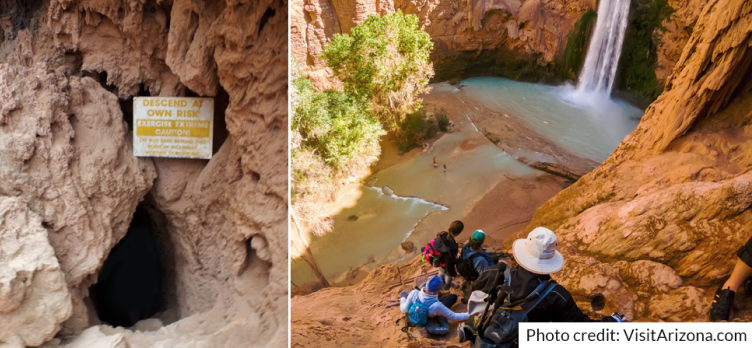
From there, it gets a little scary — you need to climb down the side of the slick mountain holding onto a chain that has been bolted onto the stone. Already deeply exhausted from the hike and recovering from ‘zombie feet,’ this was a terrifying and challenging descent but wow was it worth it. Once down in the cool and refreshing water with the huge towering waterfall, it felt almost like a spiritual moment. The best part is we had it all to ourselves! That’s the advantage of the limited amount of permits permitted and somewhat daunting entrance. Truly one of my favorite memories of all time.
After we had our fill of Moony, we climbed out the way we came in. Still a little scary, but less so now that we’ve already been there, done that. We then made our way to Havasu Falls — the iconic and most photographed waterfall of the Havasupai Falls. Getting there was pretty straightforward — there was no Lara Croft platforming needed like Mooney, you just walk right up and jump right in. Because of this, Havasu had a little more people traffic, but not by much. The strict and limited permit rules see to that.
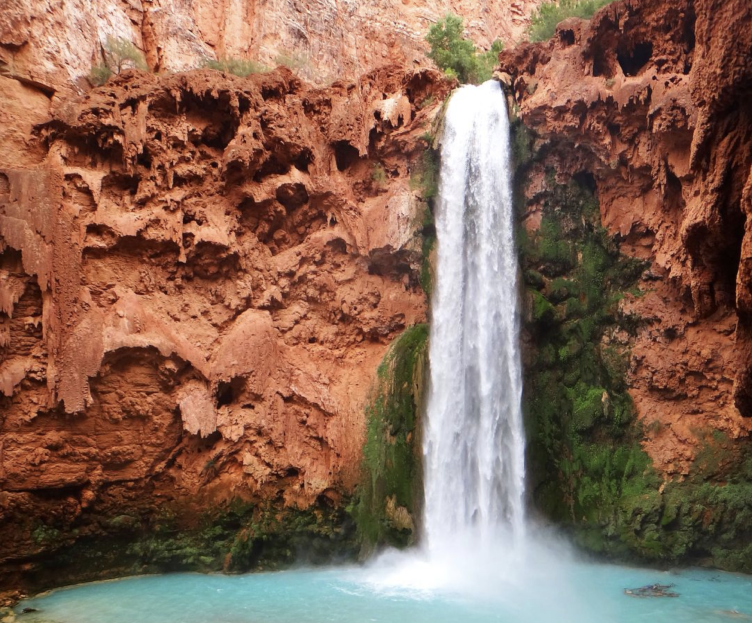
After this action-packed day, we all headed back to the campsite for some food and some laughs playing a little bit of Catch Phrase. With so much physical activity we were all wiped with most of us going to bed at 8 pm.
As I was falling asleep in our sad little lean-to, I noticed something odd. Tiny caterpillars started showing up out of nowhere — turns out they were gypsy moth caterpillars and they seemed like they were raining from the trees. Without a proper tent, we weren’t shielded from the elements and I couldn’t sleep. Every tickle I felt, I was startled awake thinking it was a caterpillar or worried I was about to crush one.
Then insult to injury struck. As I continued my sleepless night, I could hear rustling. I turned on my headlamp and caught raccoons red-handed — rummaging around in one of the backpacks that were not properly hung in a tree. This was a nightmare, first raining caterpillars, now this?
The raccoons didn’t seem phased by my proximity and only moved on when I shined a light directly at them. They certainly didn’t hurry away, but they still at least left.
The whole night, I didn’t get any sleep. Hyperaware of raining caterpillars, the raccoons were relentless at attacking our friend’s backpack, even after I hung it up in a tree between my feet. Nope, they just used my legs as a stepping stool to reach the backpack.
After one of the longest nights of my life, I was wrecked. No sleep paired with the soreness of the physical activity of the day before paired with my feet sternly saying NO to stuffing them back into the cursed boots, I was feeling worried. The hike back is infamously harder than the walk down. Ascending that last mile and a half with a tired body, and heavy backpack, I didn’t think it would be possible without proper hiking boots.
Fortunately in a huge way, once we got to Supai town, we were given the option to take a helicopter back for about 100 dollars per passenger. To that, I said an enthusiastic YES. Half of our group opted to chopper out while the other half opted to chopper out their gear but still brave the hike.
The process was a bit convoluted and confusing — we had to pay for our rides via a money order through the local post office, we put our names on a sheet of paper, and we wait. The wait ended up being over 3 hours but once we were able to helicopter out, it took less than 10 minutes. And wow was it worth it. Gave us a chance to see some cool Grand Canyon views too.
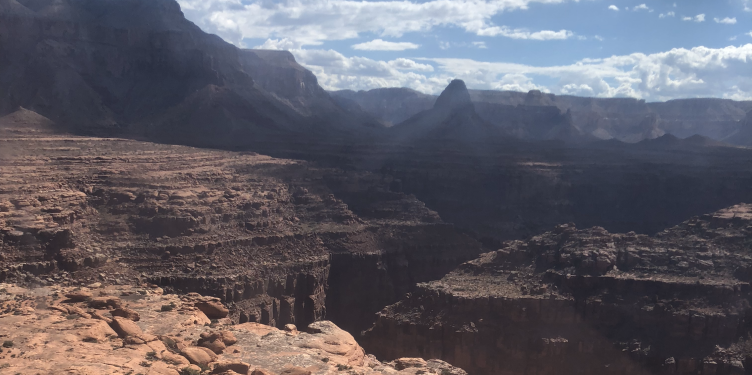
After our two days of adventure, my body decided to remind me how much I wasn’t in backpacking shape. The word “sore” does not do how I felt justice. My calves took the brunt of it — when I would start to walk I looked like a barbie trying to walk. Just doing my best on my meat sticks that have given up.
But with all that craziness, with all that fear and pain and a sleepless night, I can say in earnest that was one of the best weekends of my life. It was one of the most incredible experiences I’ve ever had, and I’ll take zombie feet, raining caterpillars, and determined raccoons any day to experience that again.
advertisement
Arizona, with its impressive diversity, surprises newcomers and constantly defies stereotypes. While many people picture endless deserts, triple-digit temperatures, and sunburn as far as the eye can see, the reality is far more varied. Here are the top 10 misconceptions about Arizona, and the truth behind them. advertisement 1. Arizona Is Just a Hot, Dry Desert Most people imagine the entire state melting under 115°F heat. And while parts of Arizona (like Phoenix and Yuma) are famously sizzling, the state also has snow-covered mountains, forests, alpine lakes, and ski resorts. Flagstaff, for example, sits at around 7,000 feet in altitude
A towering wall of dust can roll across central Arizona on a monsoon evening, swallowing skylines, grounding flights, and cutting visibility to near zero across parts of the Phoenix metro. Spectacular? Absolutely. Routine? In the Southwest, yes. These dramatic dust storms—called haboobs—are a hallmark of Arizona’s summer monsoon. Here is what they are, how they form, and how to stay safe when one arrives. advertisement What Is a Haboob? A haboob is a fast-moving dust storm generated by thunderstorm outflow winds. As a storm cell collapses or surges forward, dense, cool air rushes toward the ground and spreads outward like
Coyotes are as much a part of Arizona’s landscape as saguaros and sunsets. Known for their adaptability and eerie night calls, these wild canines have become one of the state’s most fascinating and misunderstood residents. Whether spotted trotting across desert trails or heard howling in suburban neighborhoods, coyotes embody the untamed spirit of the Southwest. advertisement Masters of Adaptation Arizona’s diverse terrain — from the Sonoran Desert to pine-covered plateaus — offers coyotes a variety of habitats. Few animals are as flexible in their survival strategies. Coyotes thrive in deserts, forests, grasslands, and even urban environments like Phoenix and Tucson.
Arizona might be known for its sun-soaked deserts and dramatic red rock formations, but the Grand Canyon State also offers incredible water adventures for locals and visitors alike. From lazy tubing down rivers to kayaking through canyons, there’s no shortage of aquatic fun to cool off under the Arizona sun. advertisement 1. Tubing the Salt River No Arizona summer is complete without a float down the Salt River in Mesa. This laid-back, family-friendly activity lets you relax as you drift through stunning desert scenery while spotting wild horses along the banks. Bring sunscreen, water shoes, and a waterproof speaker for
advertisement
| Cookie | Duration | Description |
|---|---|---|
| cookielawinfo-checkbox-analytics | 11 months | This cookie is set by GDPR Cookie Consent plugin. The cookie is used to store the user consent for the cookies in the category "Analytics". |
| cookielawinfo-checkbox-functional | 11 months | The cookie is set by GDPR cookie consent to record the user consent for the cookies in the category "Functional". |
| cookielawinfo-checkbox-necessary | 11 months | This cookie is set by GDPR Cookie Consent plugin. The cookies is used to store the user consent for the cookies in the category "Necessary". |
| cookielawinfo-checkbox-others | 11 months | This cookie is set by GDPR Cookie Consent plugin. The cookie is used to store the user consent for the cookies in the category "Other. |
| cookielawinfo-checkbox-performance | 11 months | This cookie is set by GDPR Cookie Consent plugin. The cookie is used to store the user consent for the cookies in the category "Performance". |
| viewed_cookie_policy | 11 months | The cookie is set by the GDPR Cookie Consent plugin and is used to store whether or not user has consented to the use of cookies. It does not store any personal data. |
